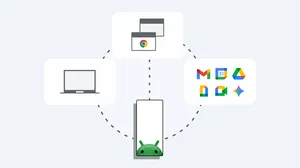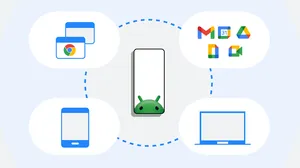How Android Enterprise supports a Zero Trust security model

The surge in remote and mobile working has put an increased emphasis on how organizations should best manage and secure device access to critical information. New research from Omdia, in a survey of 700 IT decision makers, found that businesses are expanding and strengthening access controls now that many employees spend very little or no time in the office.
This has piqued interest in the Zero Trust security model, which is built on the premise that access to corporate resources should continuously be verified. In the Omdia survey, 31 percent of the respondents are currently using Zero Trust, with another 47 percent planning to do so in the near future.
Understanding the Zero-Trust security model
The Zero Trust security model enables a mobile and remote workforce to securely connect to company resources from virtually anywhere. Devices are vetted before being granted access to company resources. Companies can use tight, granular controls to specify the level of access whether the devices are connected to a corporate network, from home, or elsewhere.
An effective Zero Trust implementation requires numerous device signals, context and controls to make intelligent decisions about access. A key piece of a Zero Trust architecture is the enforcement point, which is the identity or network component that grants or denies access based on the various device and user signals that are available. For example, the enforcement point may decline access to devices that do not have the most recent security patch or show signs of running a compromised operating system.
A Zero Trust diagram showing how various device and user signals are used as part of contextual rules that dictate the control.

How Android enables a Zero Trust security approach
Android has a wealth of platform features and APIs that our enterprise mobility management and security partners leverage to safeguard backend services and resources. Let’s look at how Android provides the building blocks you need for a Zero Trust deployment.
Android provides a variety of device signals that administrators can use in building systems to verify the security and integrity of devices. In a Zero Trust model, these signals are used to assess whether a device should be allowed to access corporate information.
The first thing that needs to be checked is the OS version and Security Patch Level of the device. The SafetyNet Attestation API verifies a device has not been rooted, while the SafetyNet VerifyApps API checks for the presence of malware. Admins can also confirm if applications are complying with Android security standards. The NetworkEvent and SecurityLog logs provide data to check for any suspicious activity or anomalies on devices.
The next aspect is context:
Who is trying to access a particular resource—are we sure that this is in fact the right device and person?
What resource are they trying to access—is this resource restricted to a select audience or region?
When are they trying to access it—is this during work hours or after hours?
Where are they trying to access it from—are they in their normal region or traveling?
How are they attempting to access it—are they accessing this from a web app or native app, is the device fully managed or BYOD?
Why do they need to access it—is this someone who typically accesses this information?
Putting Zero Trust to work for you
Now that we have device security signals and the context we can decide how to control the access to the information.
Here are some examples:
If a user is on a rooted device — no access.
If a user is traveling international — limited access.
If a user is trying to access a resource for the first time in a while — prompt for a second factor during the authentication flow.
The Android platform provides the signals and intelligence in order to understand the context and define appropriate controls in a Zero Trust deployment. What makes Android unique as a Zero Trust endpoint is that unlike other operating systems where you need to rely on the Enterprise Mobility Management (EMM) solution to gather the appropriate device signals and attributes, on Android access to these signals can be delegated so that which ever component is acting as the enforcement point; whether it be the identity provider or the network access control component, can collect all of the necessary information directly off the endpoint device as opposed to integrating with a multitude of backend systems.
If you are currently using Zero Trust or moving in that direction, make sure to confirm that your EMM or your enforcement point can access the plethora of signals directly from the device. And check out the Omdia security report to learn more about growing adoption of Zero Trust security.







